

The Rhino Orphanage. Tasmanian Devils, Tasmanian Devil Pictures, Tasmanian Devil Facts. As comical as it is, the familiar Looney Tunes portrayal of a Tasmanian devil as a seething, snarling, insatiable lunatic is, at times, not all that far from the truth.
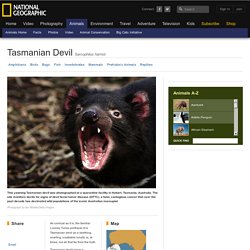
Tasmanian devils have a notoriously cantankerous disposition and will fly into a maniacal rage when threatened by a predator, fighting for a mate, or defending a meal. Early European settlers dubbed it a "devil" after witnessing such displays, which include teeth-baring, lunging, and an array of spine-chilling guttural growls. These famously feisty mammals have a coat of coarse brown or black fur and a stocky profile that gives them the appearance of a baby bear. Most have a white stripe or patch on their chest and light spots on their sides or rear end.
Tropical Rain Forest: an Endangered Species Spotlight Topic. Tropical rain forests once blanketed the Earth like a wide green belt around the equator.
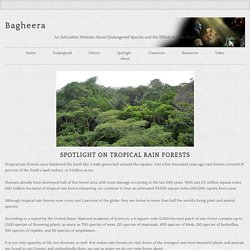
Just a few thousand years ago rain forests covered 14 percent of the Earth’s land surface, or 5 billion acres. Humans already have destroyed half of this forest area, with most damage occurring in the last 200 years. With just 2.5 million square miles (647 million hectares) of tropical rain forest remaining, we continue to lose an estimated 93,000 square miles (150,000 square km) a year. Although tropical rain forests now cover just 2 percent of the globe, they are home to more than half the world’s living plant and animal species.
CHART: endangered mammals. Endangered species. XClose Terms and Conditions of Use of Materials Copyright in this website and materials contained on this website (Material) belongs to Wildscreen or its licensors.

Visitors to this website (End Users) are entitled to: view the contents of, and Material on, the website; download and retain copies of the Material on their personal systems in digital form in low resolution for their own personal use; teachers, lecturers and students may incorporate the Material in their educational material (including, but not limited to, their lesson plans, presentations, worksheets and projects) in hard copy and digital format for use within a registered educational establishment, provided that the integrity of the Material is maintained and that copyright ownership and authorship is appropriately acknowledged by the End User. End Users shall not copy or otherwise extract, alter or manipulate Material other than as permitted in these Terms and Conditions of Use of Materials. Green-flagged material. The world's 100 most threatened species. Silky sifaka lemurerist (Propithecus candidus), fewer than 1,000 still alive The World's 100 most threatened species[1] is a compilation of the most threatened animals, plants, and fungi in the world.
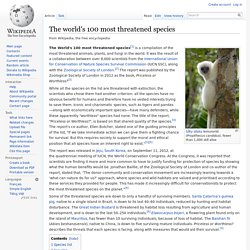
It was the result of a collaboration between over 8,000 scientists from the International Union for Conservation of Nature Species Survival Commission (IUCN SSC), along with the Zoological Society of London.[2] The report was published by the Zoological Society of London in 2012 as the book, Priceless or Worthless? [3] While all the species on the list are threatened with extinction, the scientists who chose them had another criterion: all the species have no obvious benefit for humans and therefore have no vested interests trying to save them.
Iconic and charismatic species, such as tigers and pandas—along with economically important species—have many defenders, while these apparently "worthless" species had none. Species list[edit] See also[edit] References[edit] External links[edit] Rainforest Animals. Rainforest Biomes. The tropical rain forest is a forest of tall trees in a region of year-round warmth.
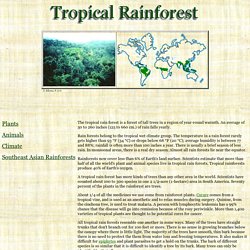
An average of 50 to 260 inches (125 to 660 cm.) of rain falls yearly. Rain forests belong to the tropical wet climate group. The temperature in a rain forest rarely gets higher than 93 °F (34 °C) or drops below 68 °F (20 °C); average humidity is between 77 and 88%; rainfall is often more than 100 inches a year. There is usually a brief season of less rain. In monsoonal areas, there is a real dry season. Rainforests now cover less than 6% of Earth's land surface. A tropical rain forest has more kinds of trees than any other area in the world. About 1/4 of all the medicines we use come from rainforest plants. All tropical rain forests resemble one another in some ways. Despite these differences, each of the three largest rainforests--the American, the African, and the Asian--has a different group of animal and plant species.
Rainforest Animals. Flora Fauna Web - Home. Which Animals Live In Rainforests? Which Animals Live In Rainforests?
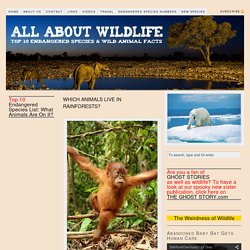
Orangutans Do. Photo: Wikimedia Commons Rainforest Animal Species. Rainforest Animals. Advertisement.

EnchantedLearning.com is a user-supported site. As a bonus, site members have access to a banner-ad-free version of the site, with print-friendly pages.Click here to learn more. (Already a member? Click here.) Rainforests are tremendously rich in animal life. Different animals live in different strata of the rainforest. Animals of the Rainforest.